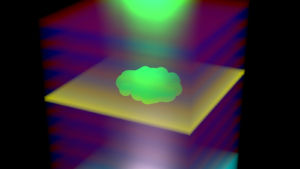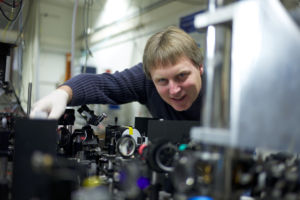
A lot of the fascination with sci-fi movies stems from a successful blend of state-of-the-art science and technology with what might be considered an imaginable extrapolation of it. For a scientist, of course, it is especially interesting if one’s own research field is depicted. A recent example is the movie Spectral, which can be described as a mixture of a war and a ghost story, where soldiers face an enemy with seemingly supernatural properties.
Well into the movie (and after a lot of people are killed along the way), the main hero, DARPA researcher Dr. Mark Clyne, has a “eureka” moment when he realises that the mysterious creatures are, in fact, fashioned out of Bose–Einstein condensate. Wow! One of my fields of research for the past 15+ years!

Bose–Einstein condensate is not a 3D printed material as suggested in the movie; it is much more complicated. Counterintuitively, in contrast to blowing things up as in one of the first scenes of the movie, laser light can be used to cool a very dilute cloud of atoms to less than a thousandth of a degree above absolute zero—a method invented in the 1980s and recognised with the Nobel Prize in Physics 1997. (Former US energy secretary Dr. Steven Chu was a co-inventor.)
With an additional step called evaporative cooling, the temperature is then further lowered to less than a millionth of a degree above zero, at which point the atoms almost come to a standstill. The particles lose their individual nature and behave like one giant super-particle—the Bose–Einstein condensate. It resembles one huge quantum mechanical wave, and it is exactly this feature that makes Bose–Einstein condensate extremely interesting for applications and fundamental studies.
Bose–Einstein condensates not actually robust

In fact, their heat capacity (i.e. the ability to drain heat from another body) is so low, you would not even be able to cool a small grain of sand with it, let alone whole people. Furthermore, condensates must be kept in the dark because they would evaporate under illumination due to the energy of the absorbed photons.
Turning this on its head, the susceptibility of Bose–Einstein condensate to every little disturbance can be exploited for ultra-sensitive applications in probing magnetic fields, accelerations, and even gravitation.
A little truth is contained in the hand-grenades made from iron particles that are used against the condensates in the movie. Indeed, magnetic stray fields induced by iron could disrupt the traps which are usually required to prevent Bose–Einstein condensates from touching the walls of the “thermos.” Hence, iron could “kill” the condensate. In real-world applications and study, apparatuses to contain condensate are built from non-magnetic stainless steel or glass.
At IBM Research, my colleagues and I have been able to produce a special type of condensate with much easier methods, even at room temperature. The downside of these methods compared to producing the condensates in ultracold gases is that they only exist for a few millionths of a millionth second—a few picoseconds. While this seems extremely short to do something useful, it is actually enough time to study certain phase transitions and interesting non-equilibrium dynamics.
The key feature of the Bose–Einstein condensates is that they magnify quantum mechanical phenomena, which govern the nanoscale up to macroscopic dimensions. Incorporated in a so-called quantum simulator that allows scientists to control and manipulate the quantum fluid, this could lead to a better understanding of fundamental properties of materials, and new approaches to tweak them for the design of novel materials.
Spectral features fragments of many promising technologies in a quite gloomy setting. As a scientist, I am driven to find out new things about nature and invent technology for the betterment of all. If sci-fi movies help to foster a similar interest among the general public and budding scientists, I’m all for it. But remember: Bose–Einstein condensates are not evil. They are just cool!
reader comments
61